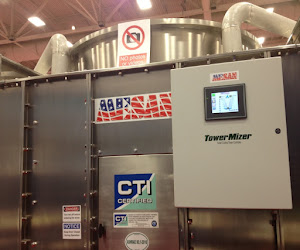Ways to improve water efficiency.
There are four areas where cooling tower water consumption can be reduced:
1) Evaporation:
Evaporative cooling is integral to open loop cooling towers, accounting for around 86% of cooling tower water consumption (AIRAH, 2010) and cannot be significantly reduced without degrading the cooling tower’s performance. However, locating the system in a hot and windy position will increase water waste. By reducing the heat load on the cooling tower using a dry or closed loop system, the evaporative cooling work can be reduced.
2) Blow-down
Blow-down water is a vital process to preserve long life and efficiency of equipment as it reduces the build up of solids (salts, dirt, calcium, rust) in the system. The frequency of blow-down discharge is typically monitored by measuring cooling water conductivity. Water consumption can be reduced by:
• Improving the quality of feed water
• Optimizing the cooling tower process, and
• Removing solids from blow-down water before
Recirculating this water into the system. It is possible to reduce blow-down volume without compromising plant longevity and efficiency by automating blow-down based on the conductivity of the circulating water to maintain the maximum allowable solids/conductivity (while staying within system requirements).
3) Reuse of Blow-down
A growing number of companies are now collecting blow-down water for reuse onsite instead of using
potable water. Blow-down water is typically higher in dissolved solids but can be (provided there are no harmful chemical treatments or risks of biological contamination) used for:
• wash down
• cleaning, and
• toilet flushing.
Depending on the types of plants and grasses in the gardens blow-down water can be used to offset or replace irrigation water. [It is wise to test this water on a small section of the gardens to see if there are any negative effects.] Blow-down can also be deionised and reused in the cooling circuit [provided there is chemical compatibility].
4) Drift, Splash-out, overflow and other losses
Cooling tower efficiency can be improved by locating the tower in areas not exposed to high winds or excessive heat. Winds can cause spray drift and splash out from air inlets. Design features such as drift eliminators or internal walls will reduce water loss in open loop cooling towers. In some cases, drift from the cooling towers may pose a public health issue. Overflow can happen when a poorly adjusted float valve (or bad design) lets the tower overfill until water flows straight out the overflow and into the sewer. This problem can be avoided by checking during routine maintenance and by monitoring water consumption. Overflow water can also be diverted to storage for reintroduction either with or without processing for use in the make-up water. Make-up water is the water added to compensate for all the water losses through the system. The more efficient the system the less make up water required. Leaks can be detected either by inspection, performing a mass balance or direct metering of flows. Leaks, however small in appearance, can be significant, in some cases 30% of a company’s water usage.
Checklist of Water Efficiency Improvements
1 - Calculate cooling tower water efficiency using the cooling tower water efficiency calculator.
2 - Determine a baseline and compare with industry benchmarks. This will also help assess the success of each water saving action.
3 - Ensure make up water valves and overflow valves are correctly set.
4 - Eliminate all leaks and monitor consumption.
5 - Check if make-up water can be replaced with recycled, rain or storm water feeds.
6 - Improve plant design, location and environment to optimize efficiency.
7 - Pre-cool water with a dry heat ex-changer to reduce heat load on cooling tower (hybrid systems).
8 - Improve plant design to eliminate overflow, splash-out, and drift.
9 - Continuously monitor blow-down water to maintain a higher average conductivity, thus reducing total blow-down.
10 - Investigate and implement recycling blow-down for reuse.
*References: AIRAH, Dec 2010, Cooling system water efficiency study project report.

.jpg)
.jpg)
.jpg)
.jpg)
.jpg)


.jpg)








